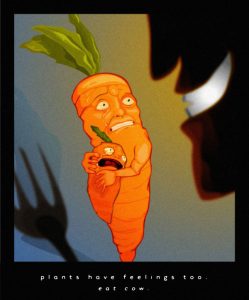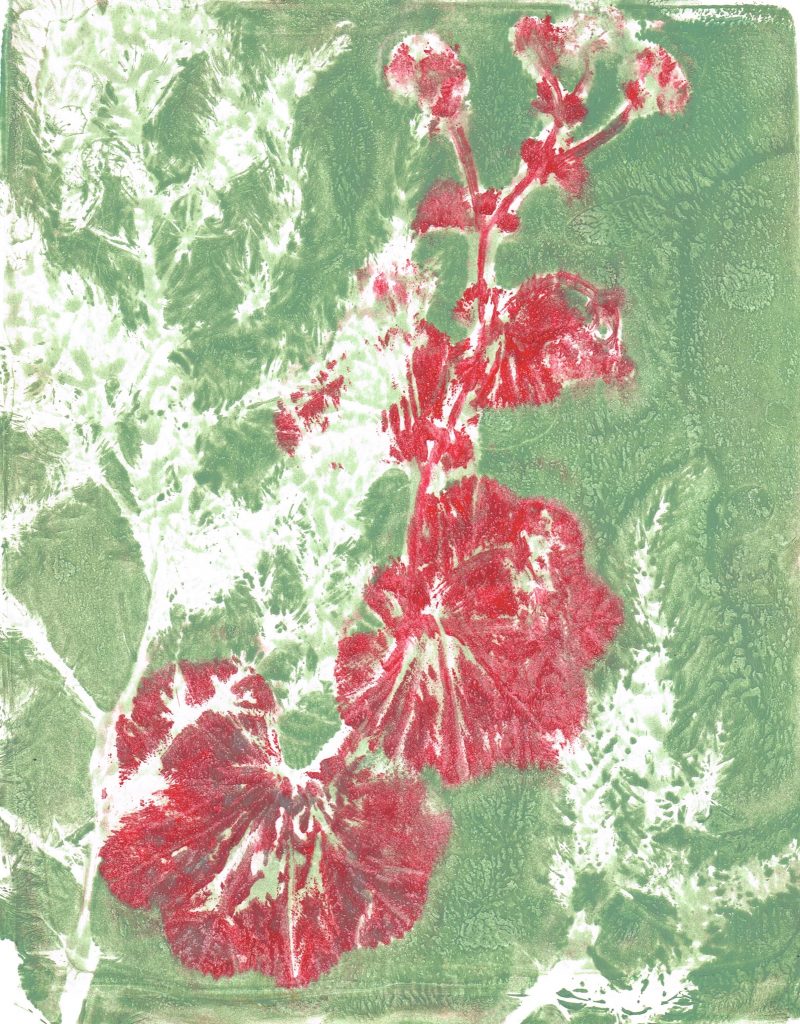
Every once in a while, when I say I am an “ethical vegan”(1), someone will pipe up “What about plants? Don’t they have feelings too?” This question is clearly a ploy to discredit animal sentience as a guide to our ethical eating choices…But it gets me thinking what about plants?
Since the seventies, interest in the intelligence and responsiveness of plants has been growing. In this blog I want to briefly discuss plant intelligence and sentience, introduce the work of an artist I metwho explores the luminous world of plants. and finally, to present a few plant mono prints I made specifically for this post.
Plant Intelligence – the Research
Since the pseudo-scientific book, The Secret Life of Plants by Peter Tompkins and Christopher Bird, was published in 1973, interest in the intelligence and sentience of plants has been growing. It is evident that plants move and communicate albeit in ways that are largely imperceptible to humans. According to many researchers, intelligence from a plant point of view entails intentionality regarding how plants grow to take advantage of resources or to defend against threats. More generally, plant intelligence is defined as the capacities plants have that enable them to do well according to their unique perspective as expressed at the cellular, organismic and environmental levels (2).
In a 2017 journal article “Are plants sentient?”, researchers contend that plants have distributed nervous systems based on bioelectric fields that are distributed throughout the plant. This nervous system provides the potential for assessment in all parts of the plant and resolving the signals would be similar to the function of an animal’s brain in arriving at physiological responses to the environment (3).
I watched a great TED talk by Stefano Mancuso (4) in which he describes distributed plant intelligence capabilities that enable plants to respond to gravity, light and to seek out resources, and also to communicate with other plants and animals through electrical and chemical signals. The intelligent is rooted in the plants’ apexes – the growing areas, which exhibit the same electrical potentials that neurons in our brain use to exchange information. Rather than centralizing intelligence in the brain, plants have evolved to use distributed processing which enables them to survive predation.
The luminous world of plants – the work of Marie-Jeanne Musiol
I felt the work of Marie-Jeanne Musiol was a wonderful way to illustrate the possibilities of plant intelligence.
On June 13, 2018 I attended an artist talk by Marie-Jeanne Musiol about her participation in the exhibition “Le Rêve des forms/ The Dream of Forms,” presented at the Palais de Tokyo from 14 June to 10 September 2017. Works of participating artists and scientists explored new possibilities of representation, to shake up our way of seeing and showing. Musiol submitted a small series of images entitled “Journeys into the Fields of Light” to the exhibition.
Bridging art and science, Musiol’s work represents new ways of looking at plants. Using electromagnetic photography she records the bio-energetic fields that surround plants to reveal intelligent vibrations and frequencies. Musiol became interested in moving beyond the visible while working at Auschwitz in the 1990s. In search of a deeper understanding of connections between matter and light, her black and white images and films reflect the dynamism of living plants. Her work has appeared in many Canadian and international exhibitions and she has a new book called The Radiant Forest, An Energy Herbarium. Marie-Jeanne Musiol was born in Switzerland and lives and works in Gatineau, Quebec. Check out her website.

My Plant Monoprints
Early June is a beautiful time in my garden. I harvested a few ferns and asparagus fronds and some flower stems for mono-printing using my gel plate and Akua printing ink. These images do not purport to capture the intelligence or inner radiance of the plants but these two prints are visually interesting and were fun to make.


